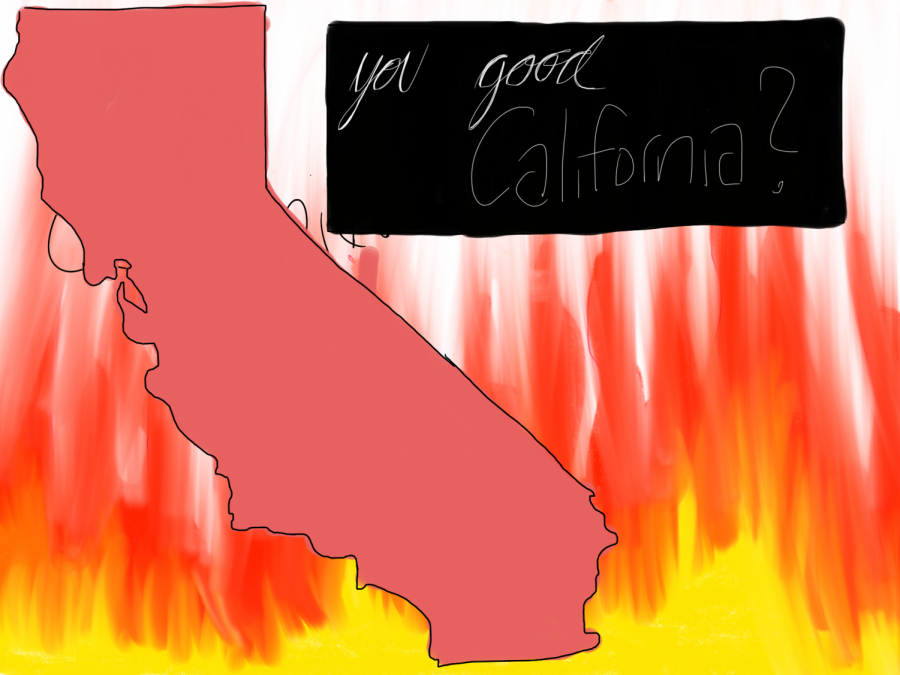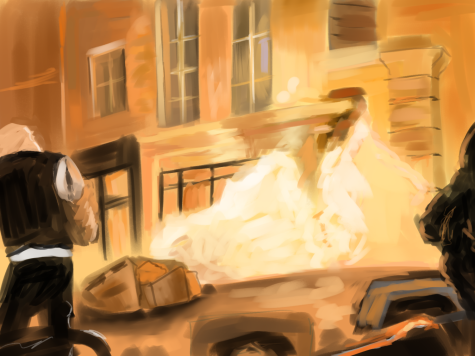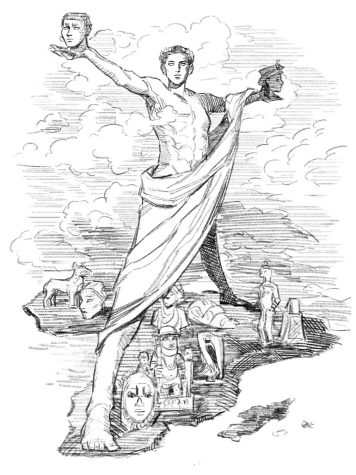The California Fires: Golden Blaze Across the Golden State
November 19, 2019
For the past month, fires have been raging throughout California. Flames engulfed lands rapidly in both the forested and coastal parts of the state.
In the sprawling suburban area surrounding Los Angeles, intense blazes spurred chaos among the population. A little after midnight on Monday, October 28, the Getty Fire erupted in the hills around the Brentwood neighborhood, causing residents to evacuate. Soon after, helicopters doused the area, in an attempt to protect the priceless artworks at the Getty Center, and the unique architectural masterpiece of the building itself. In addition, firefighters helped prevent the blaze from taking up the multi-million dollar houses of the area. Air tankers dropped red fire retardant to create a fire barrier. Despite such commendable efforts, the fires spread across 600 acres over a short period of time, and eight houses were destroyed. Fortunately, nobody was hurt.
As for the nation’s famed wine country of Sonoma County, a whopping 10,000 acres were lost within just hours of the start of the fire. Located 400 miles north and an estimated 8 hours away from Los Angeles, Sonoma County experienced wind gusts in the 50 to 100 mile-per-hour range. In contrast to the Getty Fire of Los Angeles, Sonoma’s fire was coined the “Kincade Fire.” Compared to the meager number of people evacuated in the city of Angels, over 156,000 people were under mandatory evacuation orders in Sonoma. To intensify the situation, Pacific Gas and Electric (PGE) cut power for over 880,000 people. In fact, officials and local authorities suspect PGE equipment to be a cause of the Kincade Fire, one of the many wildfires made vicious by climate change. Moreover, PGE itself reported to state regulators that its lines, poles, and transformers might have been involved in three other fires.
Both these disastrous wildfires were whipped up by fierce seasonal fall winds, the Santa Ana winds in the south and the Diablo winds in the north. Santa Ana winds are hot and dry winds that originate in the great basin of Nevada and the western half of Utah. These winds circulate in a clockwise motion, ultimately spilling over the Sierra Nevada Mountains into California and sliding down slopes. Such winds get compressed as they slide down slopes, warming the air by 30 °F for every degree of lost elevation. Naturally, these winds accelerate like a funnel through the gaps in mountains, reaching intense speeds of roughly 100 miles-per-hour while absorbing all the moisture from vegetation. Sadly, these winds carry the smallest bit of burning embers far away, lighting up forest fires along the way. The Diablo winds of the north operate in a similar fashion, igniting dry trees in seconds.
However, what complicated things the most was the lack of cell phone service. Precautionary blackouts during the fires cut power to many cell phone towers. AT&T and Verizon were the only two carriers that had a battery power backup at all of their cell phone towers. As a result, in Sonoma County alone, one quarter of the 436 cell phone towers were not functioning, and in general, cellular service was quite spotty. Additionally, in Paradise, California, teachers had to conduct classes in lantern light, while anxious parents with no cell service or power tuned to their car radios to get crucial information about their children.
Amid these devastating fires, California authorities declared a state of emergency in late October, as 48 of its 50 counties were under red flag warnings. Experts predict longer and more damaging wildfire seasons since California is facing higher temperatures, lower snowpack, drier forests, and rising sea levels, due to global warming. On a positive note, the Ronald Reagan Presidential Library was saved by a herd of goats which was employed to clear flammable brush surrounding the library. The goats helped ease the job of local firefighters when the area was eventually threatened by the Easy Fire.
And just like the grazing goats, through every scar of smoke there is always golden hope for the Golden State.
[1] https://www.nytimes.com/2019/10/29/us/california-fires-kincade-getty.html
[2] https://www.latimes.com/science/la-sci-climate-change-predictions-progress-20190626-story.html
[3] https://www.fire.ca.gov/incidents/2019/
[4] https://www.ucsusa.org/resources/global-warming-western-united-states



